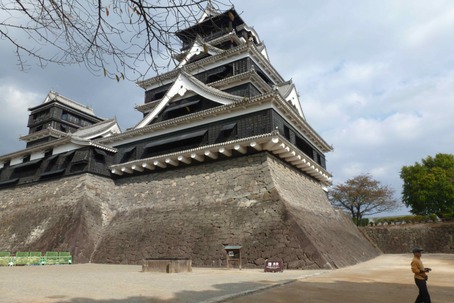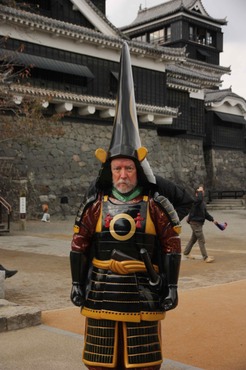
The Shinkansen line, of course, is going to avoid, or go over, urbanized areas, so the bullet train corridor might well be seen as the exception to the rule. Our experience the following day, however (he wrote, two days after the events he's chronicling) suggested that forested ridges are the rule rather than the exception in the centre of the southern part of the island.
The original plan had been to conclude the day's travels at Kumamoto, move on from there through the back blocks to Kagoshima on Thursday and do the big leg back to Osaka on the last day of the two week rail pass, but some sort of complication ruled that one out, and Plan B had a three and three-quarter hour stop in Kumamoto before we moved on to Kagoshima.
The main purpose of the stop was to take a look at Kumamoto Castle, and although only a few structures date back to the castle's construction in 1607, the reconstructed castle is one of the most impressive in Japan, rated alongside the white-walled Himeji and black-walled Matsumoto. With around eight hundred cherry trees, the castle is a popular sakura venue in late March and early April each year and although the keep and most other buildings are reconstructions, the work is high quality and new buildings are continually being added..The original construction, designed and supervised by Kato Kiyomasa, the feudal lord (daimyo ) who ruled the area, took seven years following the Battle of Sekigahara, though its foundations date back to 1467. Because of faithful service to Tokugawa Ieyasu, Kato had been awarded the whole of Kumamoto Prefecture, then known as Higo Province, and constructing Kumamoto Castle was part of his efforts to unify and develop the region.
) who ruled the area, took seven years following the Battle of Sekigahara, though its foundations date back to 1467. Because of faithful service to Tokugawa Ieyasu, Kato had been awarded the whole of Kumamoto Prefecture, then known as Higo Province, and constructing Kumamoto Castle was part of his efforts to unify and develop the region.
Kato built fortifications highly regarded for their defensive capabilities, and a number of castles he designed in Korea during the Imjin War were able to repel much larger forces because of their effective design. Kumamoto Castle, was considered an almost impregnable fortress thanks to its defensive features, particularly the curved stone walls and wooden overhangs, designed as protection against the ninja.
Less than fifty years after it was completed the castle and surrounding area were given to the Hosokawa clan which ruled the area for the next two centuries. Following the Meiji Restoration (1868), the castle played a pivotal role during the Satsuma Rebellion when Saigo Takamori led an uprising against the new government. Kumamoto was the main garrison of government troops in Kyushu, and Saigo attacked the castle in early 1877. Despite being outnumbered government forces were able to withstand a two month siege, forcing the rebel forces to retreat.
The original castle keep burnt down just before the siege, but in 1960 a ferro-concrete reconstruction re-created the exterior and a recreation of the Honmaru Goten Palace, created to celebrate the castle's 400th anniversary opened to the public in 2008.